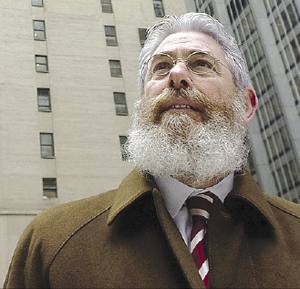Trending
What does it take to make a comeback?
Sources say developers can return from real estate purgatory -- but only if they handled their troubled projects well

Shaya Boymelgreen
Embattled developer Shaya Boymelgreen recently announced that he’s looking for development opportunities in Manhattan.
That may sound surprising, given that the erstwhile developer of 20 Pine is facing a bevy of lawsuits by creditors and disgruntled buyers, and his LibertyPointe bank was shut down by regulators in March. But a possible comeback by Boymelgreen — a high-profile casualty of the downturn — is not as outlandish as it seems, experts say.
As Donald Trump famously demonstrated with his dramatic comeback from his 1990s financial troubles, the real estate industry is surprisingly forgiving. The many developers whose projects crumbled during the downturn are likely unable to borrow money right now — especially if they went to war with their lenders. But with a little pluck and perseverance, most will be able to do projects again in the future, experts said. Those who will bounce back the fastest are the developers who established themselves before the downturn, but had a tough time during this cycle.
Many consumers, meanwhile, seem more focused on finding the perfect apartment than digging up information about a developer’s last project.
“The fact that someone was foreclosed on, or the bank took back the deed, is not necessarily a death sentence for the future,” said industry veteran Jack Levy, a senior managing director of residential management and marketing at Rose Associates. “Many people have failed and come back.”
As real estate observers well know, the financial crisis arrived swiftly and spared few. Any developer with a project on the market during that fateful time was forced to watch helplessly as prices plummeted and sales slowed to a trickle. Some have been able to renegotiate their loan terms or find additional sources of capital, but others lost their projects — or are about to lose them — after running out of time and money.
But that doesn’t mean their real estate careers are necessarily over. The impact of those struggling projects “is going to depend on how they handled it,” explained Gregg Winter, a principal at Winter & Company Commercial Real Estate Finance, which arranges commercial mortgages for multifamily apartment buildings, office buildings and other properties.
For one, it doesn’t just come down to money. There is a sort of moral code in real estate finance, industry veterans say. Lending is based heavily on relationships that are built up over time, especially when huge sums of money are involved, explained Eric Anton, an executive managing director and principal at Eastern Consolidated.
“When one of the leading industry veterans, like a Larry Silverstein or Bill Rudin, calls a bank president, it’s not like a 22-year-old calling his credit card company asking for an extension,” Anton said.
Banks, of course, are most concerned with whether or not they get their money back, but they also pay attention to how borrowers behave when faced with financial difficulty. Developers can dig in their heels and fight their lenders in court, or they can accept their share of the responsibility, do their best to repay the money owed, and turn over the keys if necessary.
The latter option may not be in the developer’s short-term economic interest, but it is likely to mean better future lending relationships, since the banks are more likely to blame the project’s failure on the market, not the developer.
“If the developer handled himself with integrity, he will live to fight another day,” Winter said. “He’s not going to be blacklisted in the lending community.”
Anton said he’s involved in a deal now where a developer fell behind on his payments, but then helped pay to finish the project, even though he had no chance of recouping his investment and was losing money. When the project was completed, he handed the keys over to the bank.
As a result, despite the fact that the developer defaulted, “the lender was happy with him, and they’re looking at new deals together,” Anton said.
By contrast, if a developer decides to file for bankruptcy, or sue to hang on to the property, he will likely have trouble borrowing money again in the near future, especially with that particular bank.
But even an ugly legal battle doesn’t mean a developer is finished for good.
“There’s a short memory on the part of these banks,” noted Josh Guberman, president and CEO of Core Development Group. When the economy heals in a few years and banks want to do deals again, “the scale of this business is big enough that there’s always a new guy, a boutique lender, a fund, willing to listen,” Guberman said.
Every situation is different, and only time will tell if Boymelgreen and others like him can stage a comeback. But experts said experienced players — like the Harry Macklowes and Jerry Speyers of the world — are more likely to receive a get-out-of-jail-free card from lenders than small-time developers.
“There’s a credibility curve that a bank goes through and once you’re established, they’re more receptive to second chances,” Guberman said. “There are only a handful of guys who have two or three decades of experience and success and history. Even if there’s a slightly tarnished track record, banks are beholden to guys like that for bigger deals.”
Consumers also seem to have a short memory, which can help developers overcome past problems.
One of the developers of 123 Third, for example, is Andrew Bradfield, who was also one of the developers of the boutique Soho project No. 22 Renwick. As The Real Deal reported, buyers at No. 22 Renwick sued last year, refusing to close on their units and claiming that the sponsors had conducted a “sham closing” at the building. Eventually, the attorney general allowed a number of the buyers in contract to get their money back. Bradfield is now being sued for fraud by the project’s lender, Broadway Bank (now MB Financial Bank). Bradfield’s attorney, Robert Braverman, called the suit a “nonsense claim” and a “desperate act of a bank on the brink of failure,” arguing that it was filed to deflect attention away from improprieties committed by the lender. The suit is ongoing, and the building is still unfinished.
But despite those problems, 123 Third is selling quickly.
Phillia Kim Downs, a salesperson at Citi Habitats who represented a buyer at 123 Third, said some of the potential buyers she’s spoken to asked about Bradfield’s track record. However, she said, Bradfield has a new partner at this project, F & T Group, a fact that “seems to ease most concerns.”
Mostly, she said, buyers seem focused on the property.
Despite the great potential for second chances in New York, most developers are unable to get construction financing, since banks are only interested in very well-capitalized partners.
“At the end of 2010, construction lenders want to know that the developer has the capacity to handle cost overruns without going straight back to the lender,” Winter explained. Moreover, “they want to know that the [borrower] is not suffering in other jobs.”
Of course, he said, that currently disqualifies “95 percent of the people out there.”
That means developers have had to find alternative solutions. One option is to team up with equity partners, like opportunity funds, Winter noted. This isn’t ideal for developers, because debt is generally cheaper than equity, but it may allow hard-hit developers to get back in the game.




